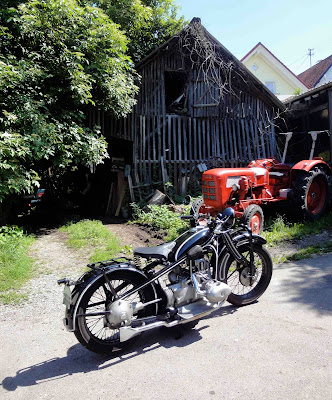While Brooklands was built 'the old fashioned way', by piling up earthen mounds and digging out the track near the river Wye at Weybridge (see some historic photos here), Montlhéry was designed and built as a modern piece of engineering, using a lattice of reinforced concrete beams and pillars to support the high banking. The near-vertical top section of the track was designed to withstand use by racing cars up to 1,000 kilos (2,200lbs) moving at 140mph (220km/h). Motorcycles present no such hazard to the infrastructure!
Having walked the complete circuit and raced on the track, I encourage anyone with a passport and an appreciation of racing history to make a pilgrimage next May 8/9, 2011, and see the place for yourself. The facilities are a bit crude, but it's possible to camp in the forest inside the circuit, which has a grubby charm, as many of the competitors are camped as well, with their vehicles - a relaxed opportunity for a conversation.
If you have the opportunity to enter a racing motorcycle, I can imagine few opportunities to sample an extant Vintage track, on which an incredible legacy of speed events was laid. Every long-distance speed event, from 1, 12, or 24 hours, was held post-war at Montlhéry, from the Velocette 24hr/100mph record, to the less successful attempts by Vincent at 24hrs, Norton's streamliners, plus a host of European factory attempts. (For a video of several ex-record breakers on the banking, click here)

My own experience of the circuit is sadly limited to one weekend in 2000, where I was invited to ride a '49 MkVIII Velocette KTT by my friend Rob Drury. While camping conditions were primitive, my personal hygiene was forgotten once I was underway in a pack of racers in my class. The Velo seemed perfectly matched with a Mondial 250cc racer with full dustbin fairings, and we always seemed to round the hairpin on the 'road' section at the same time, his lithe machine undercutting the much heavier Velo every time! Frustratingly fun.

Riding the banked track is an acquired taste, and most riders preferred to keep fairly low on the track and their speed down. You won't get up above the top white line at less than 100mph, at which point you're literally perpendicular to the slower riders below. I've passed other motorcycles from every vantage point - inside, outside, crossways - but never while looking at the top of their helmet! Disorienting at first, but after a few laps it became really enjoyable and the chicane set up to slow riders down mid-bank was ignored by the lustiest riders, without censure from the organizers I might add.

The surface of the track brings to mind the many descriptions of Brooklands in the 1920s onward, as the plates of concrete paving began to settle and shift. Bumpy! But still better than most California backroads... although I imagine riders took quite a pounding after a few hours at full chat.

The future of the Montlhéry track always seems uncertain; the Coupes Moto Legende hasn't been held there for almost 10 years, so a weekend at the track will be welcome in 2011. There are consistent rumors that the track will be torn down, as the proximity of this large plot of acreage to Paris makes the land worth billions. But, what price history?

ADDENDUM: Below is a note from the organizers..
“VINTAGE REVIVAL” AT MONTLHERY
Plans are well advanced for a vintage gathering next year at Montlhéry, the dates being 7th and 8th May 2011. Many will remember the tremendous atmosphere of the events a decade ago and it is hoped to recreate this spirit in 2011.
Organisation is in the hands of two French clubs, “Vintage Revival” (of which Mrs. Jacqueline Potherat is honorary chairman) and “Patrimoine Sportif et Mécanique”.
Pre-1940 sports and racing cars and sporting motorcycles will be able to circulate on the famous banked circuit, as will racing bicycles with vintage motorcycle pacers. The less sporting vehicles of the same era will be equally welcome to attend and will be able to drive the circuit at their own pace at the end of the weekend. There will be provision for commercial and club stands.
Enthusiasts, clubs and businesses wishing to be kept informed are encouraged to register their interest by e-mail to Vincent Chamon at vintage-revival@voila.fr.
The website is at http://vintage.revival.free.fr
- Supplementary information can be obtained from Gyles Cooper, the UK representative of Vintage Revival (020 8883 1024, gpc@belette.co.uk ).




















































































